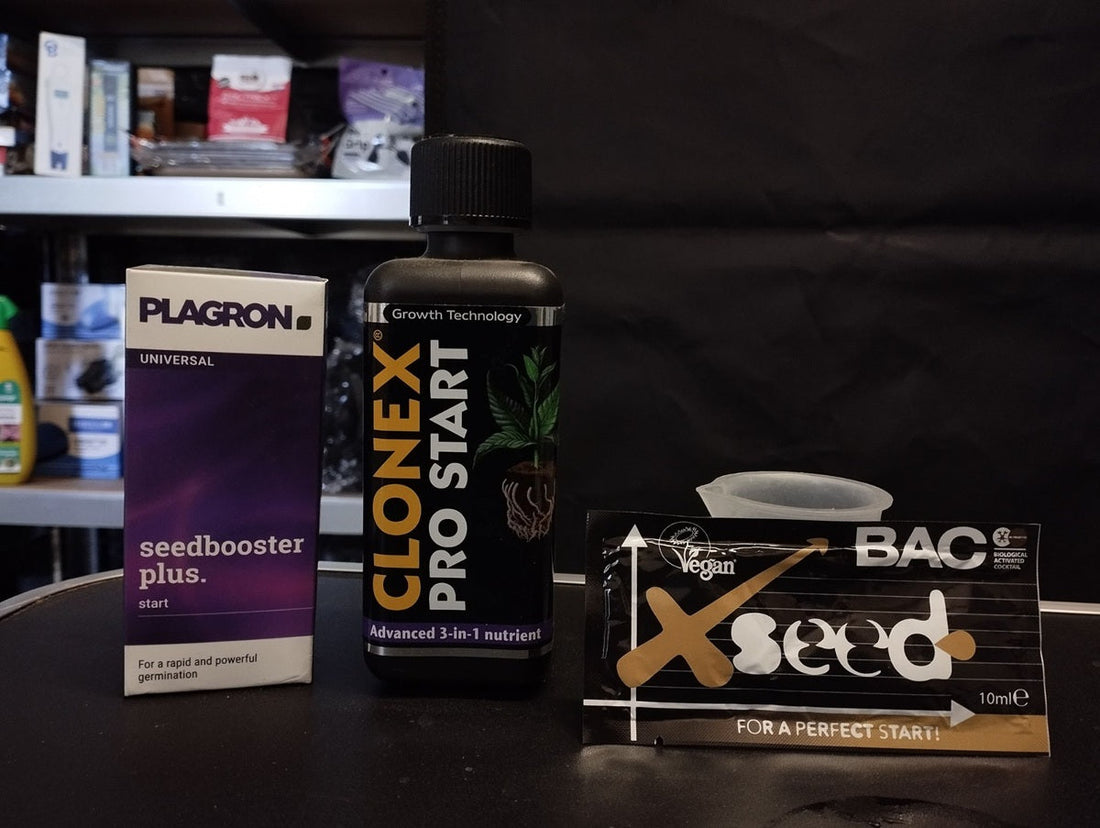
Chili seed germination test: comparison between BAC Xseed vs Plagron SeedBooster vs Clonex Pro Start 3 in 1
Share
Introduction: why test different germination stimulators?
The germination of chili seeds, especially Cayenne pepper, can be fickle, slow, and dependent on many factors. To optimize the chances of success, the use of germination stimulants has become a common practice among both amateur and professional growers. This test aims to compare the effectiveness of three popular products: BAC Xseed, Plagron SeedBooster, and Clonex Pro Start 3 en 1, under identical conditions in a mini-greenhouse with Root Riot sponges.
Presentation of the experimental protocol
Purpose of the test
Compare the speed and quality of germination of Cayenne pepper according to three different stimulants in a controlled environment. The pepper seeds had not been properly stored, simply kept in a cupboard without any regulation of storage conditions.
The varieties of chili peppers used
The test focuses exclusively on Cayenne pepper, known for its spicy taste and sometimes slow germination.
The equipment: mini-greenhouse, Root Riot sponges, and stimulators
The experiment was conducted in a mini-greenhouse using Root Riot sponges as the substrate. Each stimulator was applied to 12 sponges, totaling 36 seeds evenly distributed. The stimulators tested are:
The starting conditions of the test
Seed preparation on April 3, 2025

The seeds were first soaked in a glass of water for 6 hours at a controlled temperature, in a stable cupboard between 24.5°C and 26°C.
Controlled temperature
The mini-greenhouse was placed on a heating mat, in a stable environment around 24°C, an ideal condition to promote chili pepper germination. To ensure a stable temperature, a digital thermostat was used, namely the Cli-Mate Smart Controller temperature controller.
Soaking time in stimulator solutions

After the initial soaking, the seeds were placed in the solutions of the three stimulators for about 5 hours, before being integrated into the Root Riot sponges.
Details of the germination stimulants tested
BAC Xseed
It is a natural stimulator made from seaweed, BAC Xseed promises rapid germination and an improvement in the initial vigor of young shoots.
Plagron SeedBooster
Enriched product with minerals and biological activators, it promotes homogeneous germination and stimulates the initial growth of the root.
Clonex Pro Start 3 in 1
Designed for cuttings but also suitable for seeds, this stimulator offers comprehensive root and foliar support, although its use for seed germination is less common.
Setting up the test in the mini-greenhouse
Distribution of seeds by stimulator
Each stimulator was applied to 12 seeds placed individually in 12 Root Riot sponges, namely:
- 12 seeds for BAC Xseed
- 12 seeds for Plagron SeedBooster
- 12 seeds for Clonex Pro Start 3 in 1
Regular monitoring of germination signs
Daily monitoring was carried out to observe the emergence of the root or cotyledons.
First results observed (from April 9 to 15, 2025)

April 9: BAC Xseed launches the first germinations
As early as April 9, two seeds treated with BAC Xseed showed signs of germination.
Plagron closely follows
The Plagron then showed signs of germination, slightly behind but consistent.
Clonex: first signs on April 15
On April 15, the seeds treated with Clonex began to emerge very slightly from the soil, indicating slower development.
Comparison at D+12: evolution of the germination rate
- BAC Xseed: 6 sprouted seeds
- Plagron SeedBooster: 5 sprouted seeds
- Clonex Pro Start 3 in 1: 3 seeds at the beginning of germination
Comparative analysis: startup speed vs development speed
BAC Xseed: the fastest to initiate germination

BAC Xseed was clearly the first to trigger germination, making it an interesting choice for early results.
Plagron: rapid progress after startup

Once started, the growth of seeds treated with Plagron appears slightly faster, with more vigorous shoots.
Clonex: delay but potential for catch-up

Clonex shows slower development, perhaps due to its formulation being more geared towards "cutting" than "seeding".
Factors that can influence chili pepper germination
Temperature, humidity, light
Chili peppers require a stable temperature, high humidity, and soft light to germinate well. The mini-greenhouse provides excellent control of these parameters.
Seed and substrate quality
Cayenne seeds can vary in quality, affecting the germination time. Root Riot sponges ensure optimal aeration for root development.
Intermediate conclusion and recommendations
Most effective stimulator at this stage
For now, BAC Xseed stands out for its rapid action, while Plagron offers a more robust growth after startup. Clonex, although lagging behind, could show interesting results in the medium term.
Tips for amateur chili pepper gardeners
- Using a germination stimulator can really speed up the process.
- Stabilize the temperature between 24°C and 26°C.
- Favor a well-aerated and moist substrate (such as Root Riot).
- Be patient: peppers take time!
Upcoming follow-up and next steps
Plant development over the coming weeks
Monitoring will continue with attention paid to the growth of young plants, their foliage, and their root system.
Repotting, growth, flowering: what to expect?
Once well rooted, the young chili peppers will be repotted. The goal is to observe the initial impact of the stimulator on the overall development of the plant.
FAQ
1. Is cayenne pepper difficult to germinate?
Yes, it requires warmth, humidity, patience, and sometimes a little help through stimulants.
2. What is the ideal temperature for chili pepper germination?
Between 23°C and 28°C, with constant humidity and no drafts.
3. Is Clonex suitable for seeds?
Clonex is more often used for cuttings, but can work on seeds with variable results.
4. What is the average germination time of chili pepper?
Between 7 and 21 days depending on conditions and varieties.
5. Which stimulator seems the most effective according to this test?
At this stage, BAC Xseed is the fastest to initiate germination, followed by Plagron in post-germination growth.


